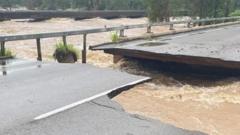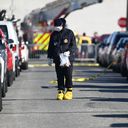Major highway partly collapses as Australian floods worsen


Investigators are early into their investigation of the plane crash in Northeast Philadelphia that killed seven people.
The big picture: The National Transportation Safety Board (NTSB), which has been on the ground since Friday, says it'll take several days — or potentially weeks — to collect and analyze evidence from the sprawling crash site.
The latest: Investigators have recovered the jet's black box, the NTSB said Sunday night.
The parts are being sent to the agency's lab in Washington, D.C. to be analyzed.
The agency said it expects to have a preliminary report done within 30 days.
Zoom in: The medical jet climbed to about 1,500 feet before descending at a 45-degree angle and crashing on Cottman Avenue about 3.5 miles away from the airport, according to city and federal officials.
"It looks like a rocket that comes straight down," David Evans, an airline transport pilot and flight instructor, told the Inquirer. "Even a Lear has some sort of glide capability. It just looks so highly unusual."
Based on air traffic control recordings, the weather at the time of the incident and publicly available flight path data, the two most likely culprits are either spatial disorientation in a low overcast cloud layer immediately after takeoff, or some catastrophic mechanical failure, Axios' Alex Fitzpatrick — a pilot — tells us.
Caveat: Only after the official investigation may we have a full understanding of what happened.
What they're saying: Tammy Duffy, a 59-year-old pharmaceutical representative from Hamilton, New Jersey, tells Axios she was stuck in rush-hour traffic near Cottman Avenue and Roosevelt Boulevard when the plane struck.
Commissioner Lisa Deeley said on X the tragedy has shaken the neighborhood where she grew up: "You see these things on TV, but it's totally different when it is in your own backyard," Deeley wrote.
Heather Long, who lives near the crash site, told Axios residents are worried about how they'll get to work this week — since many streets are still barricaded with police officers preventing traffic from entering or leaving.
"Long-term recovery": That's what the city's Managing Director Adam Thiel is warning residents to brace for as the massive effort to restore normalcy to the neighborhood gets underway.
The crash site along Cottman Avenue — a busy corridor with a mix of homes and businesses — stretches at least a half-mile between Bustleton Avenue and Roosevelt Boulevard.
Mike's thought bubble: I went down to the site Sunday and saw the usually bustling, noisy hub brought to a standstill — a surreal feeling.
State of play: Roosevelt Boulevard is expected to open by rush hour Monday morning, Philadelphia Police Commissioner Kevin Bethel said Sunday.
What we're watching: The city is still working to figure out exactly how many people were displaced or missing due to the crash.
Officials will hold a town hall meeting at 7pm on Wednesday to answer residents' questions and share more resources. The location is TBD.


:max_bytes(150000):strip_icc():format(jpeg)/Billy-Ray-Cyrus-020225-2-2e524d85bffa414ab7ac4f83de13ece0.jpg)
:max_bytes(150000):strip_icc():format(jpeg)/Sabrina-Carpenter-2025-Grammys-020225-785779c7a8af473dab955d9ff1f7b1b7.jpg)
:max_bytes(150000):strip_icc():format(jpeg)/Kim-Kardashian-020225-tout-66acac01a0f847adbd689a3525e99ea9.jpg)
:max_bytes(150000):strip_icc():format(jpeg)/miley-cyrus-grammys-2025-020225-tout-169c21a8fc684bbc8369bb74d67a4f38.jpg)
:max_bytes(150000):strip_icc():format(jpeg)/olivia-rodrigo-2025-grammys-020225-tout-05c270228107442582a1d2c2d0d0e238.jpg)
:max_bytes(150000):strip_icc():format(jpeg)/Dawes-2025-Grammys-020225-86828a14f5fb4c0a9360b3f456a01f5e.jpg)














 Beyoncé and Jay-Z are still Bonnie & Clyde, even in 2025.
In honor of the "Texas Hold 'Em" singer's historic 11 nominations, the couple stepped out in style for the 2025 Grammys on Feb. 2 at the...
Beyoncé and Jay-Z are still Bonnie & Clyde, even in 2025.
In honor of the "Texas Hold 'Em" singer's historic 11 nominations, the couple stepped out in style for the 2025 Grammys on Feb. 2 at the... Beyoncé can give high fashion in a simple white tee, but this look is next level.
Queen Bey’s arrival at the Grammys at Crypto.com Arena Feb. 2 was among her sneakiest yet. The “Texas Hold ‘Em”...
Beyoncé can give high fashion in a simple white tee, but this look is next level.
Queen Bey’s arrival at the Grammys at Crypto.com Arena Feb. 2 was among her sneakiest yet. The “Texas Hold ‘Em”... Kanye West is giving fans a closer look at his latest head-turning moment.
The “Jesus Walks” rapper shared several NSFW photos of wife Bianca Censori after the couple walked the red carpet at the...
Kanye West is giving fans a closer look at his latest head-turning moment.
The “Jesus Walks” rapper shared several NSFW photos of wife Bianca Censori after the couple walked the red carpet at the... Denial may be a river, but Doechii was dropping truth bombs during the 2025 Grammys.
In fact, the "Nissan Altima" accidentally swore on-air after making history as the third woman to win Best Rap...
Denial may be a river, but Doechii was dropping truth bombs during the 2025 Grammys.
In fact, the "Nissan Altima" accidentally swore on-air after making history as the third woman to win Best Rap... It was a party at the 2025 Grammys for Miley Cyrus and Tish Cyrus.
Despite any ongoing family drama with Billy Ray Cyrus, the mother-daughter duo put on a united front at the Feb. 2 award show,...
It was a party at the 2025 Grammys for Miley Cyrus and Tish Cyrus.
Despite any ongoing family drama with Billy Ray Cyrus, the mother-daughter duo put on a united front at the Feb. 2 award show,... Please, please, please don’t let Sabrina Carpenter’s performance end.
The “Espresso” singer—who is nominated for six Grammys at this year’s ceremony, including Album of the Year, Record of the...
Please, please, please don’t let Sabrina Carpenter’s performance end.
The “Espresso” singer—who is nominated for six Grammys at this year’s ceremony, including Album of the Year, Record of the... Kendrick Lamar may not have been at the 2025 Grammys, but he (and his feud with Drake) got quite the shout-out.
Though Trevor Noah, hosting music's biggest night for the fifth straight year, was...
Kendrick Lamar may not have been at the 2025 Grammys, but he (and his feud with Drake) got quite the shout-out.
Though Trevor Noah, hosting music's biggest night for the fifth straight year, was...